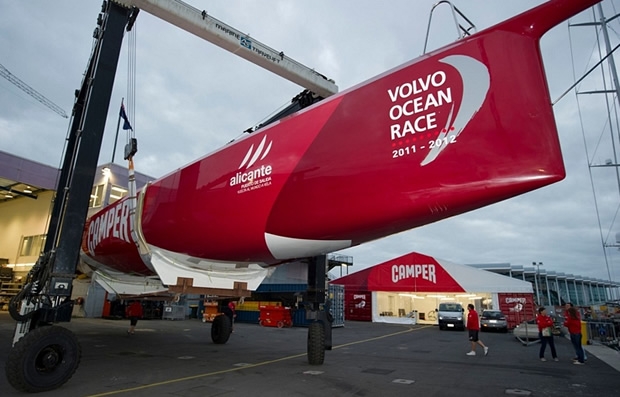The big polluters warn a carbon tax would be a disaster - jobs would go offshore, and so could whole industries. But is it true, or a giant con?
 LAST weekend, some of the Canberra Press Gallery's most senior members found themselves on a helicopter tour over Australia's north-west coast. Not a politician was in sight - just the nation's vast bounty of offshore gas. Later in Perth, they had a special briefing from Don Voelte, head of gas and petroleum giant Woodside.
LAST weekend, some of the Canberra Press Gallery's most senior members found themselves on a helicopter tour over Australia's north-west coast. Not a politician was in sight - just the nation's vast bounty of offshore gas. Later in Perth, they had a special briefing from Don Voelte, head of gas and petroleum giant Woodside.
The journalists were flown to Perth and entertained by the Australian Petroleum Production and Exploration Association, the oil and gas industry body. Its annual conference was on and, not unusually, the industry paid the airfares for business reporters to attend.
But this year was different. This year it invited senior political reporters too. The reason, it turned out, was entirely political: the industry wanted to send a message to Canberra.
And there it was in Monday's newspapers. The Sydney Morning Herald ran it on the front page. The story also led The Australian. Don Voelte, that article said, had declared a carbon tax could be the ''breaking point'' in deferring or cancelling $130 billion of gas investment. It was a plea and a threat: the liquefied natural gas industry, the political journalists reported, wanted out of Julia Gillard's carbon scheme.
Advertisement: Story continues below
In the next few months, the government will decide on a compensation package for Australia's big polluters, including the gas sector. Billions of dollars in profit are at stake. Powerful union leaders, such as the Australian Workers Union's Paul Howes, are threatening to withdraw support if ''one job'' is lost in these companies. But how many projects and jobs really are at risk? Are these warnings of economic damage, issued with increasing frequency and emotion, genuine?
It's no surprise industry is doing everything it can to secure the best deal, but its claims are often accepted without question or context. Recently, for example, a number of reports have emerged from respected investment analysts, including Macquarie Equities, Citigroup and JPMorgan, on how a carbon price will affect LNG projects and Woodside. They found that there would be a ''minimal'' impact on the sector, and a shaving of around 2 per cent from Woodside's net profit by 2013. These pieces of analysis rarely figure in the mainstream media, but you can find them in the financial press. They take into account both the whack of the tax and the cushion of the expected compensation, designed to shield Australia's energy-hungry industry from global competitors unburdened by a carbon price.
The compensation is still being negotiated, but Climate Change Minister Greg Combet has a baseline: Kevin Rudd's 2009 industry assistance package under the abandoned emissions trading scheme. The LNG industry got a special deal under that scheme - $3.6 billion worth of free pollution permits, or a carbon subsidy of $103,344 per job, according to an independent analysis by economists at Melbourne's Grattan Institute.
LNG is not alone in crying foul over the carbon tax. Aluminium giant Rio Tinto described it as ''disastrous'', coal producer Anglo American said the job impact will be ''severe''. BlueScope Steel's Graham Kraehe addressed the National Press Club last month to say the government's agenda would ''condemn us to a rusting museum''.
These comments feed the opposition's attack on the tax, which it opposes as ''economic vandalism''. Shortly after Kraehe's comments, shadow industry minister Sophie Mirabella issued a warning that the tax ''will decimate Australian manufacturing and send a tide of Australian businesses offshore''. Recently, while pedalling up the east coast, Liberal leader Tony Abbott visited a ceramic tile business and declared the tax ''will virtually shut down manufacturing in this country''.
A carbon tax will impact three broad categories of business. The power supply sector will take the biggest hit, because a carbon tax is designed to price some existing practices - such as brown-coal electricity stations - out of the market. The power industry is negotiating separately with the government. Then there's a group of companies that are trade-exposed and energy-intensive. These are the ones a carbon scheme needs to protect because they face overseas competitors not yet saddled with a carbon price, yet nudged towards cleaner practices.
Then there's the rest of business, and for them the key is energy use - the more energy a business uses, the more it will pay. An Australian Industry Group survey of its members found that, for the vast majority of businesses, energy represented just 4 per cent of sales revenue. About 70 per cent of respondents to this survey were manufacturers. Aimee Kaye, an analyst at Macquarie Securities, recently calculated the carbon tax risk for companies listed on the Australian stock exchange. Once she factored in compensation and the ability to pass on costs, no listed company had a carbon cost greater than 5 per cent of pre-tax earnings. ''So less than 5 per cent is saying it's not material for their earnings,'' says Ms Kaye.
Some companies, such as Australia's biggest, BHP Billiton, have long seen this tax coming. Several days after Ms Mirabella warned of a flood of jobs offshore, BHP announced a $US9.5 billion expansion of its iron ore and coal operations in Australia. Marcus Randolph, BHP's head of ferrous and coal, brushed off carbon tax concerns, telling the financial media the company had factored in a carbon price for years. Indeed, in contrast to its fellow heavy polluters, BHP has declared that Australia should move to price carbon, even before the rest of the world does.
But without compensation, a carbon price will push some of Australia's trade-exposed, emissions intensive industries to the wall. These companies - which dig coal, refine oil, smelt aluminium, make cement and steel and tap gas deep under the ocean - constitute about 8 per cent of Australia's gross domestic product, but produce 30 per cent of its emissions.
In April last year, the Grattan Institute - a public policy group based at the University of Melbourne and funded by governments as well as BHP Billiton - released the most comprehensive analysis of these sectors under a carbon price. The institute, which estimated these sectors employ 70,000 people, used company emissions and financial data to come to a remarkable conclusion: only two of the seven industries analysed genuinely deserved the $22 billion Rudd government compensation package.
These two industries were steel and cement. The core ingredient of cement, clinker, requires large amounts of heat. A carbon price would make imports from plants in south-east Asia and Japan - which tend to be more efficient - cheaper than locally produced cement.
Meanwhile, a carbon price is not the biggest problem for Australian steel, which produces two tonnes of greenhouse gas for every tonne of steel. But underlying issues in the industry - including ageing plants, high labour costs and the soaring price of iron ore and coal - mean a tax could make OneSteel and BlueScope marginal, leading to carbon leakage, the institute found. (Carbon leakage is when a business closes down in one place and opens in another country where pollution standards are lower, thus defeating the point of a carbon tax designed to curtail emissions).
Australia's oil refining industry, the institute said, should not be compensated because its economics were ''precarious''. For years, the industry has struggled against imports from Asian ''mega refineries''. This decline reached its logical conclusion last week, with Shell's announcement that it was closing Australia's longest running oil refinery, at Clyde in Sydney's west. Shell did not blame a carbon price.
The institute also found that Australia's $6 billion alumina refining industry, which turns bauxite ore into a white powder used to make aluminium, would remain healthy, even with a carbon price. Australia is one of the world's largest producers of alumina and does so cheaply because refineries are near high quality bauxite deposits.
LNG was not worthy of compensation either, the institute said, because it was about to boom, with or without a carbon price. And what of coal, so often the bogeyman of climate politics? The report found that a carbon price would have little impact on 90 per cent of Australia's mines, but would significantly impact the profitability of so-called gassy mines, which release large amounts of methane, a potent greenhouse gas. But they are unlikely to close, the report said, because the prices of metallurgical coal are so high.
The Rudd package was so generous, the institute said, that most of these heavy polluters would have no incentive to start moving to cleaner processes, only having to pay, in many cases, for 5.5 per cent of their pollution. It also, controversially, said that instead of compensating the Australian aluminium industry at a rate of $161,000 a job, it should be allowed to shift offshore, because its long-term future in Australia was shaky, and we make the most carbon-intensive aluminium in the world. Shifting aluminium offshore would, it said, lead to global emissions going down, not up.
Climate change minister Greg Combet, who has two aluminium smelters in his New South Wales Hunter Valley electorate, told The Sunday Age there was ''no way in the world'' the government would support that analysis. ''That's a lovely academic analysis, I say with a hint of sarcasm,'' said Mr Combet. ''Go and try and explain that to the people who have made that investment and the workers and their families.''
The aluminium industry, which employs 5000 people, also disputes the analysis - saying production will move to China, where emissions will be greater. The coal industry, meanwhile, describes the report as ''absolute tripe''. Says the Australian Coal Association's Ralph Hillman: ''Last time round we were going to see the closure of 16 mines between 2010 and 2020 and they were right across the spectrum.''
But elsewhere the report is respected. Even Keith Orchison, a former head of the oil and gas industry association, told The Sunday Age it was a ''pretty professional'' attempt at identifying the sectors ''in the gun'' and ''as good an understanding of the industry pressures as you are going to get''. An influential business figure, who declined to be named, also told The Sunday Age the analysis was the best around based on publicly available information, although it suffered from looking at risks to existing jobs and production, not those in the future.
The Greens' Christine Milne, who has signalled she wants some sort of compromise on the generosity of the Rudd package, describes the Grattan Institute analysis as ''the kind of comprehensive analysis the government needs to be doing to get to a principled approach on compensation''. That generosity was one of the reasons the party decided not to support the abandoned emissions trading scheme, arguing that the more money that goes to business, the less goes to households. The Greens also point to Treasury's finding that there was ''little evidence'' of carbon leakage under their modelling for the emissions trading scheme.
Investors, meanwhile, are watching some of the pronouncements from people such as Mr Voelte with a sceptical eye. ''Behind closed doors, companies have expressed a view that they need some certainty around a price on carbon,'' says Phillip Spathis, manager of strategy and engagement with the Australian Council of Super Investors, whose members manage more than $400 billion.
''If companies aren't dealing with it and immersing themselves instead in some sort of rhetorical table tennis, they are letting the company, investors and the whole community at large down.''
source: www.smh.com.au

















